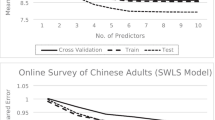Abstract
The purpose of this study was to explore whether the use of relative domain importance as a weighting mechanism at the individual level improved the correlation between the global life satisfaction and domain satisfaction measures. Results from telephone interviews with adults 50 years old or above in Chicago suggest that compared to simple average of domain satisfactions, using discrete domain importance rating as a weighting factor did not improve the correlation between global life satisfaction measure and domain satisfactions. However, the correlation was improved by using domain ranking. The findings suggest that the weighted average of domain satisfactions using domain ranking is a better indicator of global life satisfaction than the simple sum or average of domain satisfactions.
Similar content being viewed by others
REFERENCES
Andrews, F.M. and S.B. Withey: 1976, Social Indicators of Well-being: Americans' Perception of Life Quality (Plenum Press, New York).
Beatty, P. and S.A. Tuch: 1997, 'Race and life satisfaction in the middle class', Sociological Spectrum 17, pp. 71-90.
Campbell, A., P.E. Converse and W.L. Rogers: 1976, The Quality of American Life: Perceptions, Evaluations, and Satisfactions (Russel Sage, New York).
Cummins, R.A.: 1995, 'On the tale of gold standard for life satisfaction', Social Indicators Research 35, pp. 179-200.
Cummins, R.A.: 1996, 'The domains of life satisfaction: An attempt to order chaos', Social Indicators Research 38, pp. 303-328.
Cummins, R.A., M.P. McCabe, Y. Romeo and E. Gullone: 1994, 'The comprehensive quality of life scale: Instrument development and psychometric evaluation on tertiary staff and students', Educational and Psychological Measurement 54, pp. 372-382.
Diener, E.: 1984, 'Subjective well-being', Psychological Bulletin 95, pp. 542-575.
Diener, E., R.A. Emmons, R.J. Larsen and S. Griffin: 1985, 'The satisfaction with life sacle', Journal of Personality Assessment 49, pp. 71-75.
Feist, G.J., T.E. Bodner, J.F. Jacobs, M. Miles and V. Tan: 1995, 'Integrating topdown and bottom-up structural models of subjective well-being: A longitudinal investigation', Journal of Personality and Social Psychology 68, pp. 138-150.
George, L.K.: 1981, 'Subjective well-being: Conceptual and methodological issues', Annual Review of Gerontology and Geriatrics 2, pp. 345-382.
George, L.K.: 1996, 'Missing links: The case for a social psychology of the life course', The Gerontologists 36, pp. 248-255.
George, L.K. and L.B. Bearon: 1980, Quality of Life in Older Persons: Meaning and Measurements (Human Sciences Press, New York).
George, L.K., M.A. Okun and R. Landerman: 1985, 'Age as a moderator of the determinants of life satisfaction', Research on Aging 7, pp. 209-233.
Headey, B., V. Veenhoven and A. Wearing: 1991, 'Top-down versus bottom-up theories of subjective well-being', Social Indicators Research 24, pp. 81-100.
Inglehart, R.: 1978, 'Value priorities, life satisfaction, and political dissatisfaction among western publics', Comparative Studies in Sociology 1, pp. 173-202.
Lance, C.E., G.J. Lautenschlager, C.E. Sloan and P.E. Varca: 1989, 'A comparison between bottom-up, top-down, and bi-directional models of relationships between global and life facet satisfaction', Journal of Personality 57, pp. 601-624.
Larson, R.: 1978, 'Thirty years of research on the subjective well-being of older Americans', Journal of Gerontology 33, pp. 109-125.
Liang, J.: 1984, 'Dimensions of the Life Satisfaction Index A: A structural formulation', Journal of Gerontology 39, pp. 613-622.
Liang, J.: 1985, 'A structural integration of the Affect Balance Scale and the Life Satisfaction Index A', Journal of Gerontology 40, pp. 552-561.
Liang, J., R.H. Lawrence and K. Bollen: 1987, 'Race differences in the factorial structure of two measures of subjective well-being', Journal of Gerontology 42, pp. 426-428.
Maddox, G.L. and J. Wiley: 1976, 'Scope, concepts, and methods in the study of aging', in R.H. Binstock and E. Shanas (eds.), Handbook of Aging and the Social Sciences (Van Nostrand Reinhold, New York, pp. 3-34).
Mookherjee, H.N.: 1992, 'Perceptions of well-being by metropolitan and nonmetropolitan populations in the United States', Journal of Social Psychology 132, pp. 513-524.
Myers, D.G. and E. Diener: 1995, 'Who is happy?', Psychological Science 6, pp. 11-19.
Neugarten, B.L., R.J. Havinghurst and S.S. Tobin: 1961, 'Measurement of life satisfaction', Journal of Gerontology 16, pp. 134-143.
Ryff, C.D. and M.J. Essex: 1992, 'The interpretation of life experience and wellbeing: The sample case of relocation', Psychology and Aging 7, pp. 507-517.
Scherpenzeel, A. and W. Saris: 1996, 'Causal direction in a model of life satisfaction: The top-down/bottom-up controversy', Social Indicators Research 38, pp. 161-180.
Author information
Authors and Affiliations
Rights and permissions
About this article
Cite this article
Hsieh, Cm. Counting Importance: The Case of Life Satisfaction and Relative Domain Importance. Social Indicators Research 61, 227–240 (2003). https://doi.org/10.1023/A:1021354132664
Issue Date:
DOI: https://doi.org/10.1023/A:1021354132664



